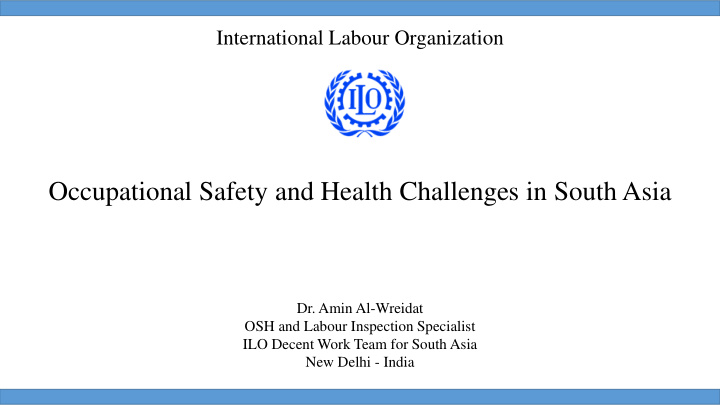



International Labour Organization Occupational Safety and Health Challenges in South Asia Dr. Amin Al-Wreidat OSH and Labour Inspection Specialist ILO Decent Work Team for South Asia New Delhi - India
Occupational Safety and Health Challenges in South Asia Challenges relating to: Policy and planning Legislation Enforcement Consultation and engagement of social partners Data and information management Resources: Human and material Awareness of OSH
Ratification of OSH and LI conventions in South Asia Country C81 C129 C155 C161 C187 India - - - - Pakistan - - - - Sri Lanka - - - - Bangladesh - - - - Nepal - - - - - Maldives - - - - - Afghanistan - - - - -
National policies on labour inspection and OSH Country LI Policy OSH Policy India No Yes Pakistan Yes No Sri Lanka Draft Draft Bangladesh Draft Yes Nepal No No Maldives Draft No Afghanistan No No
Legislation Fragmented laws Limited scope and coverage No clear standards Restricted or unclear powers and authorities of labour inspectors Inadequate and non-deterrent sanctions
Enforcement of existing legislations Weak and ineffective labour inspection services: Lack of human resources (Number, qualification, gender issues) Lack of motivation o Under payment o Lack of protection o Absence of career development systems Lack of logistics and support services Under training and poor procedures and practices Lack of modern tools for proper functioning Absence of complementary compliance strategies
Collaboration, Consultation and engagement of social partners Lack of workers’ and employers’ awareness of labour inspection and OSH. Social partners not adequately consulted or involved. Tripartite bodies on labour inspection and OSH are mostly absent or ineffective No proper cooperation or coordination mechanisms with the other concerned authorities.
Data and information management Mostly computers illiterate officials Limited access to computers and internet Manual activities and lack of use of modern technology in LI and OSH Lack of comprehensive data bases of workplaces liable to inspection
Human resources Lack of Occupational safety and health specialists/technicians Occupational health practitioners (Physicians and nurses) OSH Trainers OSH Researchers
Technical resources Lack of Specialized laboratories Training and research institutions Standard setting and monitoring institutions Educational and awareness-raising mechanisms and programmes
Other challenges Growing informal economy Expansion of flexible forms of employment Expansion of labour migration New risks associated with the use of new technology
Emerging issues Building safety and structural integrity Fire and electrical safety Export processing zones Growing labour intensive sectors (e.g. apparel industry) Specific highly hazardous sectors (Ship-breaking, brick industry, manual scavenging)
Consequences Occupational hazards remain mostly unidentified in terms of quality and quantity Work-related diseases remain unrecognized and undiagnosed – No reporting Work-related accidents and injuries mostly ignored – Under reporting Monitoring and inspection weak and ineffective Relevant complaints poorly documented and managed Statistics on occupational safety and health absent or inaccurate As a result… The problem is under estimated and continue to be ignored
Priorities at the national level Strengthening national policies on OSH Upgrading the national labour legislation Strengthening labour inspection and enhancing its effectiveness Development and adoption of new compliance strategies Building positive and preventative OSH cultures through awareness-raising campaigns and early age education Improvement of data and statistics, including those on work- related accidents, injuries and diseases. Promoting tripartite and bipartite consultation and social dialogue on OSH Establishment of OSH supporting institutions or strengthening existing ones
Priorities at the Regional level Development of a regional strategy on OSH Establishment of channels of knowledge and experience sharing among countries in the region Organizing periodic regional meetings on OSH Establishment of a comprehensive regional electronic data base on OSH
Thank You for your attention
Recommend
More recommend